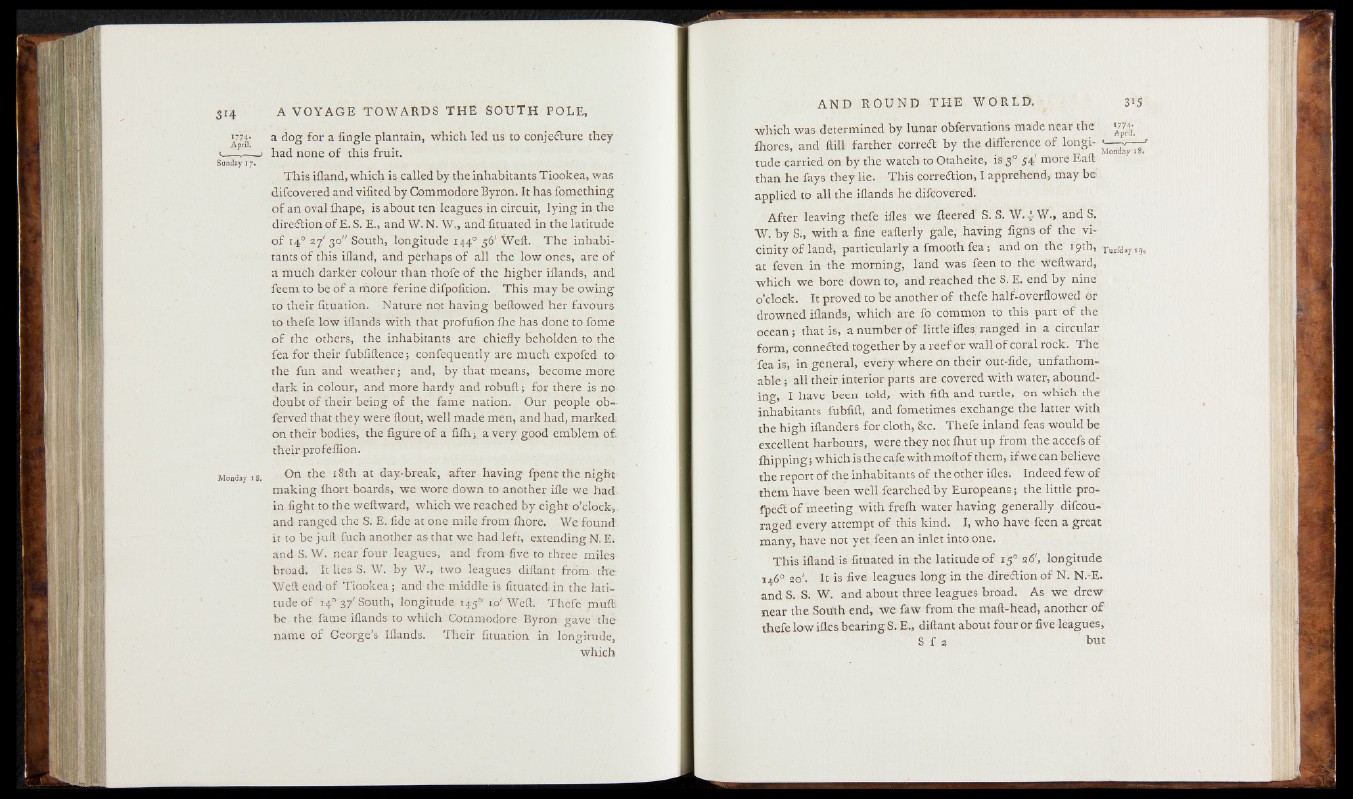
a dog for a Angle plantain, which led us to conjefture they
had none of this fruit.
This iiland, which is called by the inhabitants Tiookea, was
difcovered and vifited by Commodore Byron. It has fomething
of an oval fhape, is about ten leagues in circuit, lying in the
direction of E.S. E., andW. N. W., and fituated in the latitude
of 140 27' 30" South, longitude 1440 56' Weft. The inhabitants
of this iiland, and perhaps of all the low ones, are of
a much darker colour than thofe of the higher iflands, and
feem to be of a more ferine difpofition. This may be owing
to their fituation. Nature not having bellowed her favours
to thefe low iflands with that profufion Ihe has done to fome
of the others, the inhabitants are chiefly beholden to the
fea for their fubfiftence; confequently are much expofed to
the fun and weather; and, by that means, become more
dark in colour, and more hardy and robuft; for there is no
doubt of their being of the fame nation. Our people ob—
ferved that they were flout, well made men, and had, marked,
on their bodies, the figure of a fifh; a very good emblem of.
their profellioe.
On the 18th at day-break, after having fpent the night
making fhort boards, we wore down to another ifle we had
in fight to the weft ward, which we reached by eight o’clock-,,
and ranged the S. E. fide at one mile from Ihore. We found
it to be juft fuch another as that we had left, extending N. E.
and S. W. near four leagues, and from five to three miles
broad. It lies S. W. by W., two leagues diftant from the:
Weft end of Tiookea; and the middle is fituated in the latitude
of 140 37' South, longitude 1450 1.0' Weft. Thefe muft;
be the fame iflands to which Commodore Byron gave the
name of George’s Iflands. Their fituation in longitude,
which
which was determined by lunar obfervations made near the l j |
Ihores, and ftill farther correct by the difference of longi- ^
tude carried on by the watch to Otaheite, is 30 54' more Eaft
than he fays they lie. This corre&ion, I apprehend, may be
applied to all the iflands he difcovered.
After leaving thefe ifles we fleered S. S. W. ~ W., and S.
W. by S., with a fine eafterly gale, having figns of the vicinity
of land, particularly a fmooth fea; and on the 19th, Ta£fdayi9>
at feven in the morning, land was feen to the weftward,
which we bore down to, and reached the S. E. end by nine
o’clock. It proved to be another of thefe half-overflowed ór
drowned iflands, which are fo common to this part of the
ocean; that is, a number of little ifles ranged in a circular
form, connected together by a reef or wall of coral rock. The
fea is, in general, every where on their out-fide, unfathomable
; all their interior parts are covered with water, abounding,
I have been told, with fifh and turtle, on which the
inhabitants fubfift, and fometimes exchange the latter with
the high iflanders for cloth, &c. Thefe inland feas would be
excellent harbours, were they not fhut up from the accefs of
Clipping; which is the cafe with moft of them, i f we can believe
the report of the inhabitants of the other ifles. Indeed few of
them have been well fearched by Europeans; the little propped!
of meeting with frefh water having generally difcou-
raged every attempt of this kind. I, who have feen a great
many, have not yet feen an inlet into one.
This ifland is fituated in the latitude of 15° 26', longitude
146° 20'. It is five leagues long in the direftion of N. N.-E.
and S. S. W. and about three leagues broad. As we drew
near the South end, we faw from the maft-head, another of
thefe low ifles bearing S. E., diftant about four or five leagues,
S f 2 but